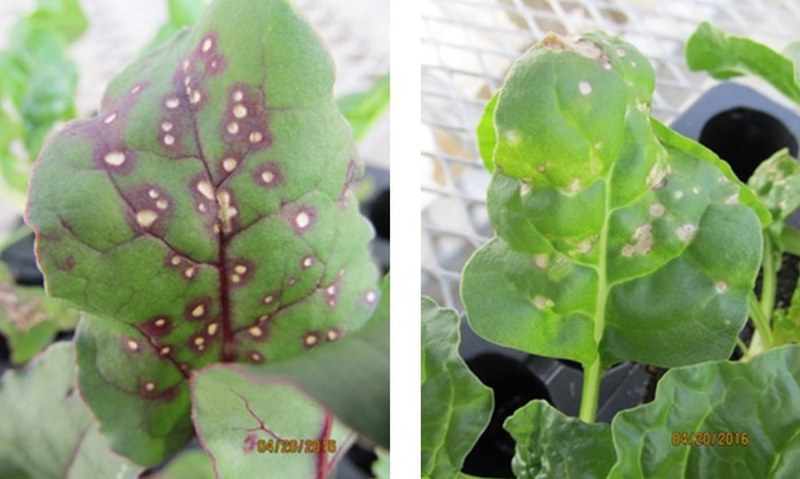Know Thine Enemy is the first rule of research for the Bull Penn Lab

(L-R) Vsevolod Soltanov, Laura Ramos-Sepúlveda, Emma Rosenthal, and Carolee Bull | Image: Marianne Stevens, Penn State University
Research in the Bull Lab specializes in translational taxonomy (basic research in taxonomy used to develop disease management strategies). Projects focus on the etiology of bacterial pathogens of plants and mushrooms and biological and nonchemical control of these pathogens. Understanding the taxonomy of bacterial pathogens and the breadth of their diversity allow us to target specific populations for disease control. Our projects are derived from real-world disease epidemics faced by crop producers. We use genetic and phenotypic data to illuminate phylogenetic and ecological relationships between the microbes and plants, the environment, and other microorganisms. This understanding is then brought back to the field to solve disease-management issues.
The Bull Penn Lab was established in December 2015 with new projects and projects that were initiated as part of the Bull Laboratory at the U.S. Dept. of Agriculture Agricultural Research Service (USDA ARS). Here we highlight a few of the projects on which the laboratory concentrates.
International efforts on the taxonomy of plant pathogenic bacteria
One of the primary goals of our program is to understand the pathovar structure of phytobacterial pathogens and to propose alternative classifications that help the understanding of the complex relationships among bacterial plant pathogens and their plant hosts (Bull and Koike, 2015). As part of this work, we evaluate the pathovar concept and how accurately it describes the pathogenic diversity of P. syringae sensu stricto (genomospecies 1). Host range and genetic diversity are evaluated for economically important seed-borne pathogens of members of the Chenopodiaceae (Safni et al., 2016 and Derie et al., 2016) and Cucurbitaceae (Figure 1; Newberry et al., 2016).

Figure 1. Bacterial Leaf Spot caused by Pseudomonas syringae on beet and chard | Image: Mike Derie, Washington State University
Significant work describing the diversity of pathogens from this taxon causing disease on beet and chard was conducted by the laboratory's first Fulbright Scholar Dr. Irda Safni from the Dept. of Agrotechnology at the University of Sumatera Utara, Indonesia. This summer, if all goes according to plan, Ms. Khumbuzile Bophela, a Ph.D. student from the Forestry and Agricultural Biotechnology Institute at the University of Pretoria, South Africa, will join the Bull Lab to work on this project as part of a bilateral partnership between our departments. Differences in natural versus experimental host range and their relative importance in the pathovar concept is explored as part of this research (Bull and Koike, 2015). Although surveys have not yet included outbreaks in Pennsylvania, the work has significance for management of bacterial diseases of cucurbits, beet, and chard in the mid-Atlantic region.
Our laboratory serves as an important source of taxonomic expertise. During the laboratory's first twelve months, Bull and Laboratory Manager/Postdoctoral Researcher Dr. Laura Ramos-Sepúlveda with the help of undergraduate researcher Vsevolod (Seva) Soltanov aided in the identification of novel pathogens causing disease on Loropetalum (Figure 2), manzanita, wheat, and barley, and first reports on numerous hosts. We continue to work on bacterial diseases of the hosts from the Apiaceae and the Cruciferae.

Figure 2. Galls on Loropetalum caused by a new pathovar of Pseudomonas amygdali | Image: Laura Ramos-Sepúlveda, Penn State University
Additionally, we have provided detailed explanations of taxonomic conundrum to researchers globally as part of Dr. Bull's service to the International Committee on the Systematics of Prokaryotes and the Convener of the International Society for Plant Pathology Committee on the Taxonomy of Plant Pathogenic Bacteria (see recent publications). Recent requests resulted in explanations concerning the invalid name Xanthomonas vasicola pv. vasculorum and clarifications of the nomenclature of pathogens in the genera Agrobacterium and Rhizobioum.
Mapping bacterial pathogens for the mushroom capital of the world
Dr. Laura Ramos-Sepúlveda leads an externally-funded project to investigate the spatial/temporal distribution of Pseudomonas pathogens of Agaricus bisporus (Figure 3). Pseudomonas species cause disease on cultivated mushrooms, and different species increase mushroom yield. However, little is known about the genetic diversity of pathogens within individual outbreaks and those associated with mushrooms. Extensive sampling followed by confirmation of pathogenicity and multilocus sequence analysis allows us to genotype organisms and observe the community during mushroom production. This information is now used to strategize biological control approaches.

Figure 3. Bacterial blotch on cultivated mushrooms caused by a variety of Pseudomonas species | Image: Carolee Bull, Penn State University
Rotten potatoes
Although blackleg is an endemic disease of potato in Pennsylvania, the severity and extent of the disease in recent years has justified renewed interest in this disease (Figure 4). The Bull and Gugino laboratories collaborate with laboratories around the U.S. to describe the genetic diversity of pathogens causing this disease and to develop novel management strategies. It is clear from surveys conducted by graduate student Christopher Ramage and others that in addition to the previously reported pathogens from the genus Pectobacterium, blackleg of potato is also caused by members of the genus Dickeya in Pennsylvania. Incidentally, as an Oregon State University Ph.D. student Dr. Bull worked on the role of siderophore production by blackleg and potato soft rot pathogens on virulence in potato (1988-1992).

Figure 4. Blackleg and soft rot of potato in Pennsylvania | Image: Christopher Ramage, Penn State University
Host pathogen interactions for bacterial leaf spot of lettuce
Xanthomonas campestris pv. vitians (Xcv), the causal agent of bacterial leaf spot on lettuce (Figure 5), reduces lettuce quality and yield worldwide. The taxonomy of this pathogen, like many pathogens in this species, is unsettled, and the Bull lab is in the process of proposing that the pathogen be transferred to X. hortorum. At the USDA ARS Dr. Bull's team and collaborators identified a broad diversity of strains from outbreaks around the world that were characterized as belonging to at least six sequence types and three races (Bull et al., 2016; Fayette et al., 2016). Strain specific host resistance was identified in a number of lettuce (Lactuca sativa) cultivars (Bull et al., 2007). In one cultivar, the hypersensitive reaction conferred by a single dominant gene named Xanthomonas resistance 1 (Xar1) confers complete resistance to one race of the pathogen (Hayes et al., 2014). On these cultivars the population levels of the pathogen are suppressed as compared to populations on susceptible pathogens. At least three races of the pathogen have been identified and distributed among six multilocus sequence types that differ for the cultivars which have HR (Bull et al., 2015). The laboratory looks forward to expanding this research to include strains of the pathogen from lettuce grown in Pennsylvania. Graduate student Emma Rosenthal, who joined the laboratory this month, will use a variety of approaches, including whole-genome sequence analysis and forward and reverse genetics, to identify the virulence genes that correspond to the avirulence genes defined in lettuce.

Figure 5. Bacterial leaf spot on lettuce caused by Xanthomonas campestris pv. vitians | Image: Carolee Bull, USDA ARS
Predators and prey: training undergraduate researchers
The Bull Lab investigates predatory microorganisms for the biological control of plant pathogens and for their roles in agroecosystems. Lines of research involving both myxobacteria and bacteriophage are pursued. We work with collaborators from the Department of Biochemistry and Molecular Biology to explore the possibility of developing these lines of research into a Course-based Undergraduate Research Experience (CURE) at Penn State. The Bull Lab invites highly-motivated graduate students who are interested in microbial predator/prey relationships, biological control, and undergraduate education to learn how they can help with this project.
Citations
- Bull, C. T., Trent, M. A., Hayes, R. J. 2016. Three races of Xanthomonas campestris pv. vitians causing bacterial leaf spot on lettuce identified. APS National Meeting, July 30-August 4, 2016, Tampa, FL.
- Bull, C. T., and Koike, S. T. 2015. Practical benefits of knowing the enemy: modern molecular tools for diagnosing the etiology of bacterial diseases and understanding the taxonomy and diversity of plant-pathogenic bacteria. Annual Review of Phytopathology doi: 10.1146/annurev-phyto-080614-120122.
- Bull, C. T., Gebben, S. J., Goldman, P. H., Trent, M. A., Hayes, R. J. 2015. Host genotype and hypersensitive reaction influence population levels of Xanthomonas campestris pv. vitians in lettuce. Phytopathology 105:316-324.
- Bull, C. T., Goldman, P. H., Hayes, R., Madden, L. V., Koike, S. T., and Ryder, E. 2007. Genetic diversity of lettuce for resistance to bacterial leaf spot caused by Xanthomonas campestris pv. vitians. Online. Plant Health Progress doi:10.1094/PHP-2007-0917-02-RS.
- Derie, M. L., Holmes, B. J., Safni, I., Bull, C. T., du Toit, L. J. 2016 Seedborne inoculum thresholds of Pseudomonas syringae pv. aptata, causal agent of bacterial leaf spot, in 'baby leaf' Swiss chard crops. APS National Meeting, July 30-August 4, 2016, Tampa, FL.
- Fayette, J., Raid, R., Roberts, P. D., Jones, J. B., Pernezny, K., Bull, C. T., and Goss, E. M., 2016 Multilocus sequence typing of strains of bacterial spot of lettuce collected in the United States. Phytopathology 106:1262-1269.
- Hayes, R. J., Trent, M. A., Truco, M. J., Antonise, R., Michelmore, R. W., Bull, C. T. 2014. The inheritance of resistance to bacterial leaf spot of lettuce caused by Xanthomonas campestris pv. vitians in three lettuce cultivars. Horticulture Research doi:10.1038/hortres.2014.66
- Newberry, E. A., Paret, M. L., Bull, C. T., Rubio, I., Jones, J. B., Babu, B., Jardini, T., Goss, E. M., Roberts, P. D. 2015. Diverse Pseudomonas syringae associated with foliar diseases of watermelon, cantaloupe, and squash. Phytopathology 105(S4):101.
- Safni, I., Sepulveda, L. R., Goldman, P. H., Derie, M. L., du Toit, L. J., Koike, S. T., Stockwell, V. O., and Bull, C. T., 2016. Genetic diversity of Pseudomonas syringae causing bacterial leaf spot on table beet (Beta vulgaris) and Swiss chard (Beta vulgaris subsp. cicla). APS National Meeting, July 30-August 4, 2016, Tampa, FL.

